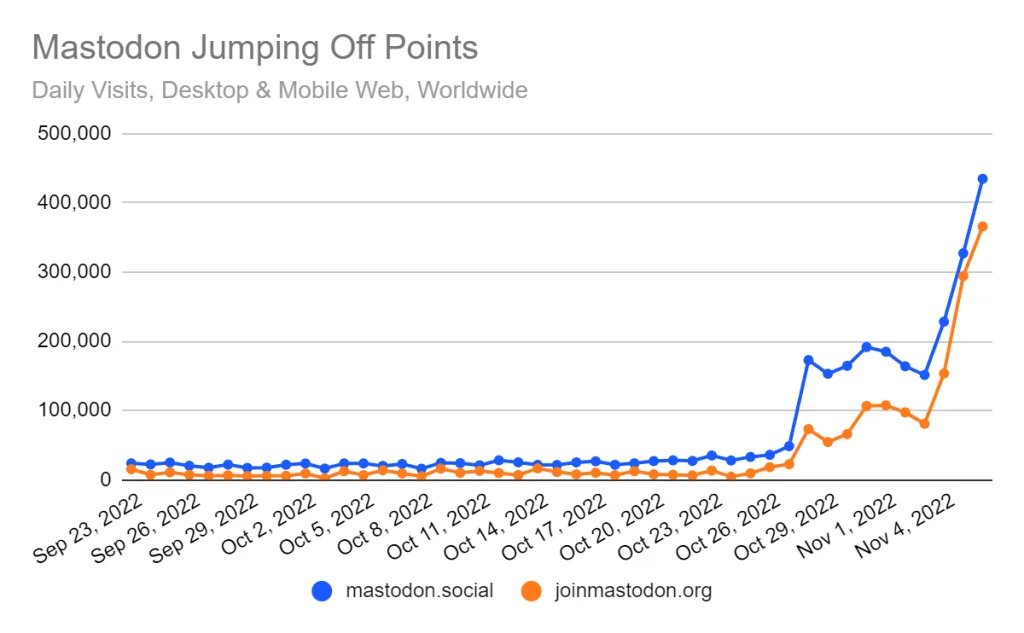It’s been less than a month since Elon Musk began his chaotic takeover of Twitter but, to many, the platform already feels like it’s entered an inevitable death spiral. Advertisers are fleeing. The few remaining top executives are also leaving. Musk’s Twitter Blue rollout was a complete disaster. The FTC says it has “deep concern” about the company. Musk told employees bankruptcy is a real possibility. Former engineers say the site could break at any moment.
Unsurprisingly, the uncertainty has inspired many users to explore Twitter alternatives. Among them, Mastodon, a decentralized platform founded in 2016, has emerged as one of the top destinations for Twitter quitters. The service saw an earlier uptick in April, when Musk’s buyout was announced, but it’s seen an even bigger flood of new users since Musk’s takeover was completed.
Between October 27th and November 6th, Mastodon gained nearly half a million new users, almost doubling its user base, according to founder Eugen Rochko. Data from Similarweb, shows that the two most popular “entry points” to Mastodon, the mastodon.social server and joinmastodon.org, are getting more than four times the amount of daily traffic compared with the end of October prior to Musk taking over the company.

SimilarWeb
It’s not the first time upheaval at Twitter has driven new users to the “fediverse,” but it’s the largest exodus. And even many of those who haven’t quit Twitter entirely have begun promoting their Mastodon accounts.
But not everyone is ready — or able— to give up on Twitter. And many don’t see Mastodon as a viable substitute for what Twitter has provided.
For Beth Hyman, executive director of the SquirrelWood animal sanctuary in New York, Twitter has for years been a vital source of donations thanks to the rescue’s popular “Crouton & Friends” account. She began to grow SquirrelWood’s Twitter presence in 2018 by posting nightly videos of Crouton, a baby cow living at the sanctuary.
Now, Twitter, where Crouton has more than 65,000 followers, is one of the sanctuary’s biggest, and most reliable, sources of donations. For example, she was able to raise $30,000 for a used horse trailer in just three days in 2021, and frequently shares other fundraisers for the sanctuary. She worries about how Twitter’s current instability could affect them. “I don’t want to see the income that helps keep this sanctuary going, and all these animals fed, dry up,” Hyman tells Engadget.
She says she signed up for Mastodon as well as CounterSocial after noticing a dip in her followers in the days after Musk’s takeover, but she’s skeptical she will be able to recreate her Twitter account’s success on a new platform. “Our main home base has always been Twitter. A lot of work goes into this, and it’s not like you just flip the switch and walk away and reignite it somewhere else,” she says.
She’s also found that it’s just not as easy to share photos and videos of SquirrelWood’s animals — the main draw for her social media followers — on Mastodon due to its file size constraints. “We’re taking care of 70 animals, I need something that I can do on the fly very easily,” she said.
For others, the decentralized nature of Mastodon has other drawbacks. Eric Feigl-Ding is an epidemiologist who grew his Twitter following at the start of the pandemic when he was among the first to go viral tweeting about the potential threat posed by the novel coronavirus. He now uses his Twitter account, where he has more than 700,000 followers, to share updates about the pandemic and to promote public health policy.
He says he tried to sign up for the mastodon.social server only to find that it was full, and that he and some colleagues are now debating starting their own server, But he worries he won’t be able to reach the same people as he can on Twitter.
“I knew I wanted to reach policymakers, members of Congress, and journalists,” he says. “Basically, people who have the power to shape public opinion, and change policy, and to move the needle on this pandemic. And Twitter is that platform. Twitter is the platform to get your message out. They’re not sitting on Mastodon.”
Feigl-Ding, who has spent a lot of time debunking COVID-19 misinformation, also worries about the consequences of leaving. “You do not want to cede the town square to misinformation, to disinfo, to slanted views on things,” he said. “You want to be there to engage, you want to show up at the debate.”
Others worry about losing the friendships and community they’ve formed on Twitter. Steven Aquino, a tech journalist who covers accessibility, says that Mastodon isn’t a realistic alternative for many people with disabilities because it lacks many of Twitter’s accessibility features. It also just wouldn’t be the same, he says. “The whole point of social media is to be social, and for a lot of disabled people … social [media] is how they interact with other humans,” he tells Engadget.
At the same time, the fact that Musk cut Twitter’s accessibility team makes him worried Twitter itself could become less usable. “The fact that they laid off the entirety of the accessibility team says a lot about what they think about people like me, and where they want the service to be,” he says.
“There’s so much being written about what Elon is doing, and hiring and firing, and those are all important things. But there is no respect for what is the real impact on the people who use the service.”
All products recommended by Engadget are selected by our editorial team, independent of our parent company. Some of our stories include affiliate links. If you buy something through one of these links, we may earn an affiliate commission. All prices are correct at the time of publishing.